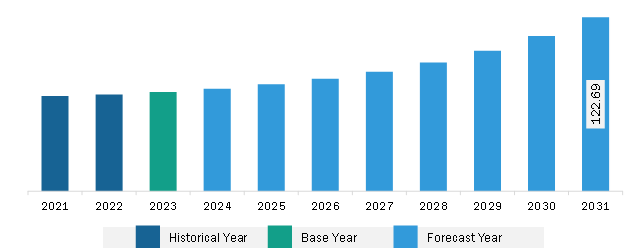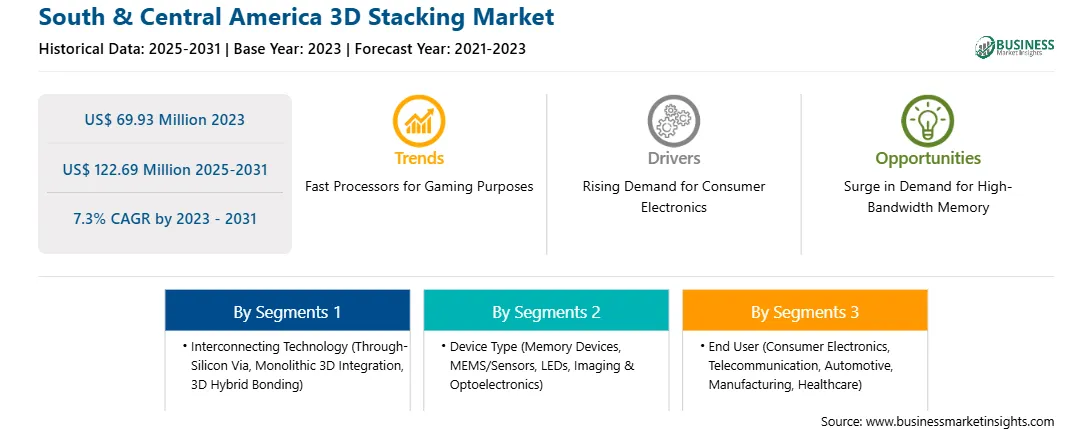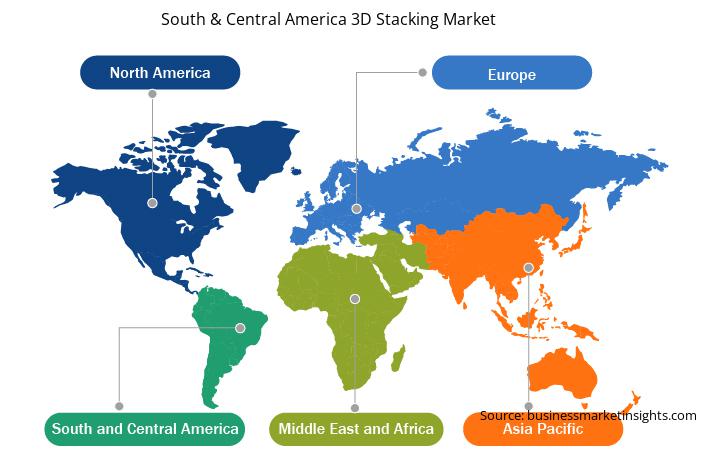The South & Central America 3D stacking market was valued at US$ 69.93 million in 2023 and is expected to reach US$ 122.69 million by 2031; it is anticipated to register a CAGR of 7.3% from 2023 to 2031.
High-bandwidth memory (HBM), which reaches extremely high density by stacking numerous dynamic random-access memory (DRAMs) vertically, is distinguished by rapid data processing and low power consumption. It is essential in high-performance computing (HPC), such as generative AI, which requires processing enormous amounts of data at significantly fast speeds. Samsung Electronics 12-layer stacked HBM uses next-generation 3D stacking packaging technique to boost performance and yield. With a processing speed of 6.4Gbps and a bandwidth of 819 GB/s, HBM3 is 1.8 times faster than the previous-generation DRAM while using 10% less power. The demand for HBM in high-performance computing applications encourages market players to increase their production. For instance, in March 2024, SK HYNIX INC started volume production of HBM3E1, the newest AI memory product with ultra-high performance. HBM3E is designed for an AI system that processes a huge amount of data quickly. The high-bandwidth memory is used by various industries, including telecommunication, automotive, healthcare, and manufacturing, for high-speed data processing.
HBM utilizes 3D stacking technology, allowing the stacking of multiple layers of chips using vertical channels known as through-silicon vias (TSVs). This enables a greater number of memory chips to be packed into a smaller space, minimizing the distance data must travel between the memory and processor. HBM can help lengthen battery life and reduce energy consumption by offering sustainable benefits to users. This supports users in decreasing the amount of power required to transmit data between memory and processor. Therefore, the surge in demand for high-speed data processing and low-power consumption memories is expected to create lucrative opportunities for the 3D stacking market growth during the forecast period.
The South & Central America 3D stacking market is segmented into Brazil, Argentina, and the Rest of South & Central America. The growing demand for CMOS image sensors in machine vision systems fuels the need for 3D stacking. The 3D stacking market growth in SAM is majorly driven by the rising demand for high-quality cameras in smartphones and tablets and the growing application of image sensors in various sectors such as medical diagnostic & image sensors and automotive. Also, the consumer electronics industry is proliferating in the region due to increasing demand for electronic devices across healthcare, consumer electronics, and manufacturing sectors. South & Central American countries such as Argentina, Chile, Brazil, and Colombia are major players in the consumer electronics industry. The growing number of consumer electronics require 3D stacking for various purposes. For example, 3D stacking is a transformative technology in consumer electronics that enables the creation of more powerful, efficient, and compact devices. Therefore, with the increase in the electronic industry, the demand for 3D stacking is also increasing in South & Central America.
Strategic insights for the South & Central America 3D Stacking provides data-driven analysis of the industry landscape, including current trends, key players, and regional nuances. These insights offer actionable recommendations, enabling readers to differentiate themselves from competitors by identifying untapped segments or developing unique value propositions. Leveraging data analytics, these insights help industry players anticipate the market shifts, whether investors, manufacturers, or other stakeholders. A future-oriented perspective is essential, helping stakeholders anticipate market shifts and position themselves for long-term success in this dynamic region. Ultimately, effective strategic insights empower readers to make informed decisions that drive profitability and achieve their business objectives within the market. The geographic scope of the South & Central America 3D Stacking refers to the specific areas in which a business operates and competes. Understanding local distinctions, such as diverse consumer preferences (e.g., demand for specific plug types or battery backup durations), varying economic conditions, and regulatory environments, is crucial for tailoring strategies to specific markets. Businesses can expand their reach by identifying underserved areas or adapting their offerings to meet local demands. A clear market focus allows for more effective resource allocation, targeted marketing campaigns, and better positioning against local competitors, ultimately driving growth in those targeted areas.
South & Central America 3D Stacking Strategic Insights

South & Central America 3D Stacking Report Scope
Report Attribute
Details
Market size in 2023
US$ 69.93 Million
Market Size by 2031
US$ 122.69 Million
CAGR (2023 - 2031) 7.3%
Historical Data
2021-2023
Forecast period
2025-2031
Segments Covered
By Interconnecting Technology
By Device Type
By End User
Regions and Countries Covered
South & Central America
Market leaders and key company profiles
South & Central America 3D Stacking Regional Insights

The South & Central America 3D stacking market is categorized into interconnecting technology, device type, end user, and country.
Based on interconnecting technology, the South & Central America 3D stacking market is segmented into through-silicon via, monolithic 3D integration, and 3D hybrid bonding. The through-silicon via segment held the largest market share in 2023.
By device type, the South & Central America 3D stacking market is segmented into memory devices, mems/sensors, LEDs, imaging & optoelectronics, and others. The memory devices segment held the largest market share in 2023.
In the terms of end user, the South & Central America 3D stacking market is segmented into consumer electronics, telecommunication, automotive, manufacturing, healthcare, and others. The consumer electronics segment held the largest market share in 2023.
By country, the South & Central America 3D stacking market is segmented into Brazil, Argentina, and the Rest of South & Central America. Argentina dominated the South & Central America 3D stacking market share in 2023.
Samsung Electronics Co Ltd; Intel Corp; Texas Instruments Inc; Advanced Micro Devices Inc.; 3M Co.; and Globalfoundries Inc are some of the leading companies operating in the South & Central America 3D stacking market.
The South & Central America 3D Stacking Market is valued at US$ 69.93 Million in 2023, it is projected to reach US$ 122.69 Million by 2031.
As per our report South & Central America 3D Stacking Market, the market size is valued at US$ 69.93 Million in 2023, projecting it to reach US$ 122.69 Million by 2031. This translates to a CAGR of approximately 7.3% during the forecast period.
The South & Central America 3D Stacking Market report typically cover these key segments-
The historic period, base year, and forecast period can vary slightly depending on the specific market research report. However, for the South & Central America 3D Stacking Market report:
The South & Central America 3D Stacking Market is populated by several key players, each contributing to its growth and innovation. Some of the major players include:
The South & Central America 3D Stacking Market report is valuable for diverse stakeholders, including:
Essentially, anyone involved in or considering involvement in the South & Central America 3D Stacking Market value chain can benefit from the information contained in a comprehensive market report.